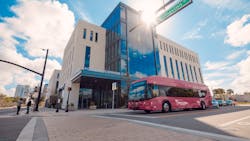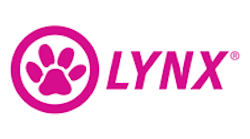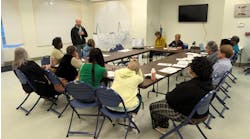Central Florida conjures several images in the mind’s eye – a family vacation, a convention, a specific mouse – but for those in the transit industry, it’s the brightly colored buses, affectionately referred to as the Skittles fleet, that may come to the forefront.
These buses represent a segment of the service options provided by the Central Florida Regional Transportation Authority (LYNX), but they also provide a metaphor that public transport is a vibrant part of the region.
“LYNX has been a three-county agency serving Orange, Seminole and Osceola counties since the 1970s,” explained LYNX CEO Jim Harrison. “This region is one of the fastest growing areas in the nation. We're well over two million residents now and we serve a 2,500-square-mile area. When you consider our annual visitor population, that increases the population count significantly. More than 50 percent of our ridership occurs on routes serving the major tourist destinations like Disney and Universal, as well as others in the area.”
There is no hyperbole behind Harrison’s fastest growing area claim. Numbers released by the U.S. Census Bureau in August 2021 show the three-county area LYNX serves saw a population increase of more than 350,000 residents in the past decade. Seminole County’s population increased 11.4 percent, Orange County’s population increased 24.8 percent and Osceola County’s population increased 44.7 percent – making Osceola the tenth fastest growing county in the U.S.
While Central Florida’s economy is largely service based, the University of Central Florida’s Institute for Economic Forecasting expects the sectors with the strongest average job growth between 2020-2023 to be financial activities; education and health services; trade, transportation and utilities; professional and business services and construction.
The main takeaway: Central Florida is growing in population and adding a diverse array of jobs, which will only increase the need for reliable transit services.
Harrison explains LYNX has a long history of being an early adopter of trends in mobility including the opening of the first bus rapid transit route in the U.S., the Lymmo Orange Line, which opened in 1997 and has since expanded to four routes. Additionally, LYNX’s NeighborLink was one of the earliest on-demand flex services designed to provide residents in less-populated areas access to local and regional transportation.
“What makes us stand out right now is that we're the only three-county transit agency that has experienced such unprecedented growth over the last decade and that growth, coupled with our funding challenges as a regional agency, has led us to be innovative in the way that we deliver our services,” said Harrison.
The stated mission of LYNX is to provide its served community with “quality mobility options with innovation, integrity and teamwork.” The third element, teamwork, is critical in execution of its mission and that extends to its regional planning and funding partners.
“Coordinated transportation planning is crucial to any successful project and certainly even more so in a fast-growing region like this. We work very closely with our partners; coordinating very carefully with our regional funding partners and the cities that we serve so that we can coordinate those services and facilities. I think working closely together is absolutely imperative as we navigate the fast moving, fast growing environment,” said Harrison.
The Transit Development Plan, a needs-based evaluation required by the Florida Department of Transportation, is one document that offers LYNX and its regional partners a chance to coordinate on the changing mobility needs of the growing region.
“The annual update allows us an opportunity to show off all the things that we've done over the year but, the major update that occurs every five years is an opportunity to take a look at how travel patterns have evolved, along with land development,” explained Harrison. “We work very closely with our regional partners to see where we can improve service and time the construction of our facilities.”
LYNX will be starting the next update shortly and Harrison notes it will involve extensive outreach of the community to account for the impact of the COVID-19 pandemic.
The effects of the health crisis did not spare LYNX; ridership dropped, costs increased, but, through the challenges, service continued.
Prior to the pandemic, there was discussion of a sales tax initiative referendum to provide dedicated funding to LYNX and other transportation projects in the Orange County. The effort proposed by Orange County Mayor Jerry Demings included a one-cent sales tax that would have generated an estimated $596 million annually for transportation funding. The county suspended pursuit of the transportation sales tax referendum due to the uncertainty brought about by the pandemic. However, Mayor Demings committed to revisiting the referendum post pandemic with the possibility that it could be ready for a November 2022 vote.
“Dedicated funding would be an absolute game changer for LYNX and for transit in the Central Florida region in general,” said Harrison. “Transit is a core need for the success of the region. Not only do we serve our tourists, but we also provide essential service for our workers and LYNX provides an excellent service. I'm very proud of what we do, but, by far, the most common concern we hear is about frequency and the only answer to that is funding.”
Current Projects Delivered Through Partnerships
Harrison notes the financial assistance provided by the federal government through the three pandemic relief bills that included the transit industry has had a critical impact on LYNX’s ability to maintain operations through the pandemic and enhance the safety of workers and riders.
He explains LYNX created a stabilization fund with oversight of the agency’s board of directors to help stabilize and mitigate impacts of what is believed will be a prolonged economic downturn.
This has provided the budgetary balance needed to LYNX so it could continue with several long-planned improvements, such as its introduction of zero-emission buses and reconstruction of several superstops.
LYNX operates a mixed fleet of biodiesel, compressed natural gas (CNG) and battery-electric buses.
“Our goal is to move away from diesel to a low and no-emission fleet,” said Harrison, noting LYNX began this initiative with the transition to CNG.
In April 2016, LYNX, as part of a public-private partnership with Nopetro, opened a six-acre CNG fueling facility capable of distributing 40 gallons per minute. Harrison describes the transition to CNG successful with about half of LYNX’s current fleet comprised of CNG vehicles.
“We are now continuing that trend towards no-emission vehicles and converting our entire downtown circulator, the Lymmo fleet, to electric,” said Harrison. “We’re working closely with the city of Orlando to utilize a public-public partnership to bring the strengths of various government agencies together.”
In late October 2020, LYNX introduced the first battery-electric buses to its Lymmo routes in downtown Orlando. The goal is to transition the Lymmo service to a full zero-emission fleet by 2025.
Orlando Utility Commission (OUC), which is part of the public-public partnership, assisted in the procurement of the charging stations that were installed at LYNX’s bus depot. The charging system is capable of fully charging LYNX’s electric buses in three to four hours. While LYNX is gaining information about the real-world operation of electric buses, OUC says it is gaining information on battery performance, as well as how to mitigate demand charges.
Funding for the electric buses was provided through a $1.9 million grant from the Federal Transit Administration’s Low or No Emission Program, as well as $850,000 in matching funds from the city and $900,000 from OUC.
“We have eight electric buses running our downtown circulator right now and we have six more ordered, which will fill out our downtown Lymmo service,” said Harrison. “The community has been very supportive and very accepting [of the electric vehicles] and, of great importance to me, so have our operations and maintenance teams. I think that this transition has been very well received.”
In addition to new vehicles, LYNX is focused on providing new and improved passenger amenities through a long-term program that includes shelter installations and superstop construction. These improvements include new benches, wayfinding signage, real-time information and other elements.
A large capital project currently underway is the rebuilding of the Rosemont Superstop, which is among the system’s 10 busiest stops serving approximately 1,500 passengers each day. LYNX is partnering with the city on the project, which began in May, to improve the superstop by increasing the amount of onsite lighting, bringing the number of bus shelters with seating to 10 (up from four), improving pedestrian crossings and building larger bus bays that can accommodate LYNX’s larger buses. Additionally, the superstop incorporates the city’s Crime Prevention Through Environmental Design principles, which ensures a safe environment.
Harrison says construction is going well on the long-awaited project, which should take a total of four to five months to complete.
“We have a number of other significant projects out there, as well,” said Harrison. “For the Pine Hills Transit Center we are in the final process of getting the permits and getting that out to bid and expect to award that project later this year.”
The Pine Hills Transit Center is designed to be a new prototype for stations on LYNX’s system. The multi-phase project will include construction of an eight-bay transfer center, real-time departure and arrival information, bicycle parking, safety and security improvements, integration with the Pine Hills Trail and a driver’s lounge. The project has been under development with several community partners to ensure it promotes economic competitiveness, advances an equitable and performance-driven transit system, delivers seamless transportation services and enhances the customer experience.
Another major project, Harrison mentions is the Florida Mall Transfer Center that is currently out to bid with a contract expected to be awarded soon. The project is another complete reconstruction of existing facilities and will include new amenities such as bus shelters and better ADA access.
“[These improvements are] certainly driven by LYNX’s communication with its customers and with regional partners,” said Harrison. “It’s a partnership.”
Looking to the Future
Future projects at LYNX will continue to be pursued and delivered using its proven strategies associated with innovation and collaboration.
One project involves coordination with the Central Florida Automated Vehicle Partnership and the city of Orlando to deploy a pilot program using automated vehicles along LYNX’s Lymmo route in an area of central business district in downtown Orlando referred to as Creative Village.
“It's a pilot program to explore the use of automated shuttles and shared use vehicles on a limited circuit,” explained Harrison. “We expect that this is going to serve as kind of a vehicle proving facility, as well as provide that important daily service.”
Another project focused on improving transit service is the SR 436 Transit Corridor Study, one of several critical corridors in the region that LYNX has conducted studies to evaluate service enhancements, but movement forward for these projects hinges on funding.
“Funding is really the key issue on the 436 study, as well as a number of other critical corridors in the region like State Road 50 and the connection between our international airport and our convention center; these have been a focus for LYNX for a long time and they were part of the financial package that was proposed by Mayor Demings and his regional funding initiative. Unfortunately, the pandemic put those projects temporarily on hold and so right now, we're working to identify funding sources,” said Harrison.
Through the uncertainty of the past year, LYNX has tapped into its legacy of innovation to continue to provide service within its community and find ways to enhance that service. The efforts, says Harrison, paints a future that, like the system’s Skittles fleet, can be described as bright.
“As we continue to be one of the fastest growing regions in the nation, there's no question that transit in all of its forms is going to be a key component to the region's success; I think our future is very, very bright,” he said.
LYNX by the Numbers
- Approximate service area of 2,500 square miles
- More than 23 million vehicle miles traveled in FY20
- 17,832,104 passenger trips in FY20
- Fleet size of more than 300 coaches
- Eight battery-electric buses with six more slated for delivery by mid-2022
Credit: LYNX

Mischa Wanek-Libman | Group Editorial Director
Mischa Wanek-Libman is director of communications with Transdev North America. She has more than 20 years of experience working in the transportation industry covering construction projects, engineering challenges, transit and rail operations and best practices.
Wanek-Libman has held top editorial positions at freight rail and public transportation business-to-business publications including as editor-in-chief and editorial director of Mass Transit from 2018-2024. She has been recognized for editorial excellence through her individual work, as well as for collaborative content.
She is an active member of the American Public Transportation Association's Marketing and Communications Committee and served 14 years as a Board Observer on the National Railroad Construction and Maintenance Association (NRC) Board of Directors.
She is a graduate of Drake University in Des Moines, Iowa, where she earned a Bachelor of Arts degree in Journalism and Mass Communication.



